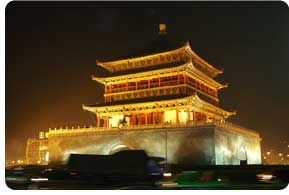 Drum Tower Drum Tower
鼓楼
The Drum Tower is located northwest of the Bell Tower of Xian, across the Bell Tower and Drum Tower Square. Both of them are called the 'sister buildings' or 'morning bell and dark drum'. In ancient China, especially from the Yuan Dynasty (1271-1368), the drums were used to signal the running of time and on occasion were used as an alarm in emergency situations.
The Drum Tower in Xian was initially built in 1380 during the reign of Emperor Hongwu of the Ming Dynasty (1368-1644), and was renovated twice in 1699 and 1740 in the Qing Dynasty (1644-1911). It is a two-storied post and panel structure, 34 meters (about 112 feet) high and 52.6 meters (about 172 feet) long from east to west as well as 38 meters (about 124 feet) wide from north to south. The architecture style of the Drum Tower is a combination of the styles of the Tang Dynasty (618-907) and the Qing Dynasty. However, the Drum Tower also has some innovative features. For example, it should be mentioned that there is no iron nail used anywhere in the Drum Tower.
Arriving at the Drum Tower you will see that there is an arched doorway in the centre of the south and north walls, doorway being 6 meters (about 20 feet) in both height and width. The north entrance leads to Beiyuan Men and south to the West Avenue. Visitors can go upstairs to the second floor, and enjoy the views around the Drum Tower. Meanwhile, you will notice that there are twenty-four drums in the north and south sides of the Drum Tower. These drums stand for the Twenty-four Solar Terms which is a kind of weather calendar created by the Chinese ancients in order to guide the agricultural production.
In modern times, the Drum Tower is not used as a timer any more, but there are some new attractions for visitors to enjoy. In the year of 1996, a new drum, covered by a whole piece of cowhide was given a place on the Drum Tower. It is the biggest drum in China at present. What is more, visitors will enjoy musical performances on the Drum Tower. These performances will enlighten one on the power of ancient Chinese culture. |



